Chilled Drink Calculator
Imagine, it's a hot summer day. You've been enjoying yourself outside for about an hour now, but you're getting a little thirsty. You want to refresh yourself. As sweat runs down your forehead, you open your favorite beverage and put the can to your lips, waiting for your thirst to be quenched. What, then, could be worse than having your expectation ruined by a lukewarm beverage? You can put your opened can into the fridge or freezer, but will this repair the damage to your psyche? More importantly, how long should you have chilled your drink beforehand for it to have reached its optimal temperature?
To resolve this compelling problem, we've designed this chilled drink calculator for you. No need to keep hurrying to the freezer to check your drink; science will give you the proper answer.
In the following article, you can find out about the ideal serving temperature of different beverages and how our ancestors cooled their drinks in the past — this isn't a new problem. We even provide a few tricks to speed up the chilling process, even if you don't have a fridge around.
We also made a video about the best drink-cooling hacks! Watch it here:
The optimal temperature for chilled drinks
First and foremost, we should try to find out what the ideal drinking temperature is for the beverages in question. Yes, yes, we know that when the sun is blazing outside, most of you like to parch your thirst with an ice-cold drink. Scientists, however, discovered that beverage intake at different temperatures could fulfill different purposes at the most. For example, that on a hot, dry day, drinking a hot beverage may cool your body better than a cold drink. But when your ultimate goal is to quench your thirst as fast as possible, , cold and carbonated beverages might be your best choice. This finding coincides with , which prove that the sensation in the mouth plays a crucial role in satiating thirst.
In this article, however, we rely prominently on the historically evolved serving habits that reflect the specific qualities of different drinks. Due to their diverse chemical structures, the temperature at which you will enjoy your drink the most will differ from beverage to beverage.
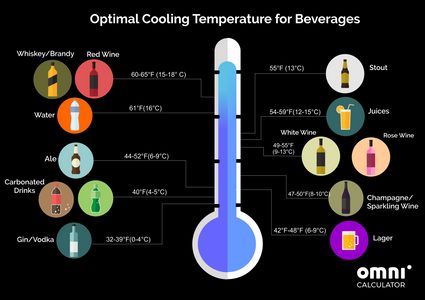
-
Wines
There is probably no other type of drink where the right temperature is so crucial. As a general rule, it's best to serve white and rosé wines at a cold temperature, around 49-55 °F (9-13 °C). This causes the wine's acidity to become more pronounced, and the wine will be fresher with a lighter taste. When it is too warm, the alcohol becomes dominant, leading to a harsh taste. However, do not over-chill - the wine may lose its flavor entirely. White wines that contain high residual sugar, such as ice wines or Tokaji Aszú wines, are best served at 50-53 °F (10-12 °C).
On the other hand, red wines are best served at room temperature. But before we proceed, let's answer the question, "What is room temperature?" It's not, as you might think, the climate in most of the modern flats. The expression dates back to medieval Europe, where it was much more difficult to control the temperature of a house. As a result, our ancestors had to bear a lower indoor temperature, around 60 °F to 65 °F (15 °C to 18°C). It is, incidentally, this temperature that best shows the fragrance of red wines while also showing off the grape's balanced taste and fruitiness.
Sparkling wines and Champagne are the drinks that you need to keep in the fridge the longest if you want to enjoy them the most. Their optimal drinking temperature is 47-50 °F (8-10 °C), with sweet aromatic sparkling wines requiring a temperature as low as 46 °F (7 °C).
-
Beers
If you envisage a bottle of beer on a hot summer day, you may associate it with super cool refreshments. However, depending on the type of beer and its qualities, the precise serving temperature may differ widely. As a basic rule, no beer should be served below 42 °F (6 °C) as ice-cold temperature dampens its flavor. Though you might enjoy a lager at the lowest temperature (anywhere from 42 °F to 48 °F (6-9 °C)), it is better to imbibe an ale that is somewhat warmer, around 44-52 °F (7-11 °C). If you prefer stout, you know that cellar temperature is the best choice, that being around 55 °F (13 °C).
-
Soft drinks
The situation is far less complicated with your favorite soda or carbonated drink: you will experience its full flavor at any temperature. Still, Pepsi and Coca-Cola recommend that their respective products be drunk at slightly different temperatures: according to their representatives, the former is best at 42 °F (5.5 °C), while the latter should be drunk at 38 °F (3.3 °C). We can probably say that carbonated beverages are best enjoyed at around 40 °F (4-5 °C).
-
Water
The jury is still out when it comes to water: your body can benefit from different temperatures depending on your taste and circumstances. Since the ultimate purpose of water intake is the quest for hydration, in this particular case, we considered the event that fulfills this function the most. Accordingly, that you can reach the optimum level of hydration if you ingest your water at around 61 °F (16 °C). Still, as we have mentioned, other studies imply that cold and carbonated water is a better choice when you aim to quench your thirst.
-
Juices
Indeed, juices are best served cold. Still, it is better not to cool them to below 54 °F (12 °C), as they may lose their sweet fruity taste. The perfect temperature for juices is between 54 °F and 59 °F (12-15 °C).
-
Liquors
Although some spirits, such as brandy or whiskey, are best experienced near room temperature, particular types are traditionally consumed cold. As you may have guessed, these are vodka and gin. When you chill them, they get a little viscous, helping mask some of their alcoholic harshnesses. Besides, cream liqueurs should be kept in the fridge, as the cold can balance the high sugar content they commonly have. Still, you better not store good quality vodka or gin in the freezer, or you will lose all of its flavor. The best temperature to serve them is 32-39 °F (0-4 °C).
The physics of chilling
Despite appearances, this calculator doesn't run on magic. Instead, it makes use of a much more powerful resource: physics! This calculator is an easy-to-use version of our own Newton's law of cooling calculator that has been modified to include technical values for the most common combinations of containers and beverages.
Newton's law of cooling:
T = T_ambient + (T_initial - T_ambient) × exp(- k × t)
which, solving for time (t), we transform into:
t = -ln[(T - T_ambient)/(T_initial-T_ambient)]/k
where:
T [K]— Temperature of the object at time t;T_ambient [K]— Ambient temperature;T_initial [K]— Initial temperature of the object;t [s]— Time spent cooling; andk [1/s]— Cooling coefficient.
The cooling coefficient is equal to:
k = h × A / C
where:
k [1/s]— Cooling coefficient;h [W/(m²·K)]— Heat transfer coefficient;A [m²]— Area of the heat exchange; andC [J/K]— Heat capacity.
As is the case with most forms of applied physics, several approximations were made, but we are confident the results should work fairly accurately in the Real World™ (and not only in a vacuum with spherical containers).
How to use the chilled drink calculator?
As we mentioned, the chilled drink calculator aims to work out the time a beverage requires in the fridge (or another cool place) to reach its optimal drinking temperature. However, with the aim of providing a more comprehensive service, we designed the platform in such a way that you can choose other pre-defined temperatures or even set the desired temperature yourself!
1. What do you want to chill?
To begin the calculation, you need to specify one of the beverages discussed in the previous section.
2. Bottle/Container
You will need to specify the size of the bottle (i.e., its volume) as this also affects the cooling process.
3. Where was the drink?
The next important factor is the initial temperature of your beverage. You may choose between three default conditions, or you can set it yourself.
4. Where did you put the drink?
Here you should select the place where you would like to chill your drink. Keep in mind that the temperature of this spot should be colder than both the initial and the optimal temperature of your beverage.
5. Desired temperature
By default, the desired temperature is the drink's optimal temperature, as defined in the previous section. This is only a default; however, you can still customize the desired temperature to fit your refreshment needs!
After setting the above specifications, you will immediately get the time your drink requires to reach its desired temperature. We have designed a dynamic chart for you as well, so you can see how the temperature of your drink changes over time. This is useful if you're too impatient to wait for your drink to cool fully and want to quickly check what the temperature of your drinks will be after a specific time.
The history of cooling techniques
Even though the mechanical refrigerator is a relatively new invention, the history of cooling beverages does not begin there. Ancient civilizations, such as the Greeks, Romans, and Chinese, cut and stored ice that would then be added to their refreshments. In other places, where ice was in short supply, people kept water in porous clay vessels that functioned as natural evaporative coolers.
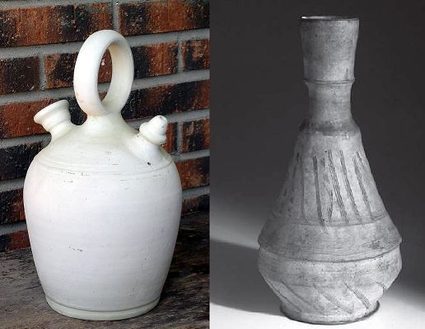
Surprisingly, the main instrument for refrigeration remained natural ice until recently, but its usage was mostly limited to the elite of societies. It was only in the eighteenth century that icy drinks became affordable to the general public. The real demand, however, appeared only in the middle nineteenth century.
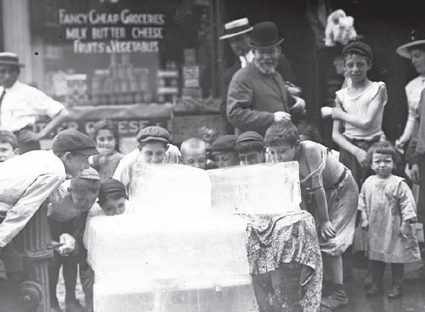
It was around this time that an American businessman, Frederic "Ice King" Tudor, appeared. Already an influential ice-harvesting figure, Tudor decided to launch a global scale venture to promote his expanding ice sales. This was how America became more and more fascinated with chilled drinks, and, at the end of the nineteenth century, people in most American cities used iced drinks as their main means of refreshment. Natural ice, however, requires a sophisticated supply line, which made it relatively expensive. This cost drove the development of the mechanical refrigerations that emerged in the middle of the nineteen century. The fact that one of the first modern refrigerators was advertised as cooling a bottle of champagne in ten minutes illustrates the strong human desire for chilled drinks.
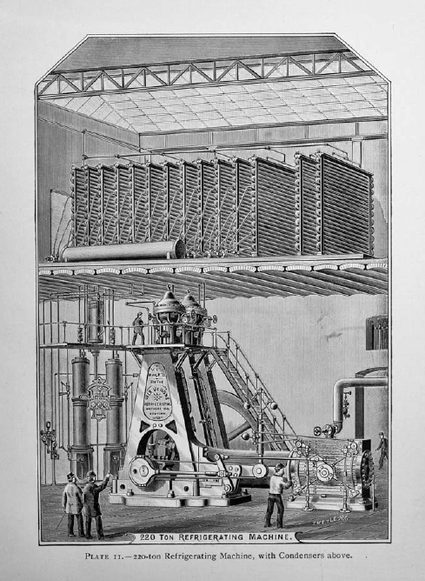
Mechanical refrigerators were initially huge and only really saw use in industry. Home refrigerators tended to be simple ice boxes with limited space and effectiveness. In the 1920s, thanks to accelerated technological advancements, mechanical fridges became smaller and more affordable, leading to refrigerate becoming common place and easily accessible to most households.
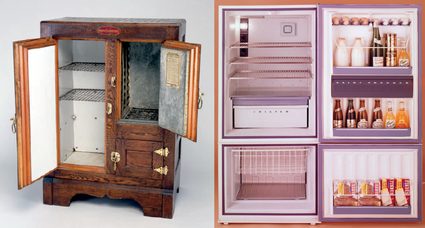
Beverage cooling hacks
If you are in a rush to chill your beverage, or there are many drinks to deal with, you can use some of these tricks to accelerate the cooling process:
-
Wet paper around the bottle
You can combine multiple types of techniques to speed up the procedure. One option might be to wrap the bottle with a wet paper towel before placing it in the fridge or freezer. The low temperature of the fridge leads to an accelerated evaporation process, meaning that the water in the paper towel removes energy from the bottle even quicker, creating an extra cooler.
-
Salty-ice-water bath
If there is no room in your fridge, but you have some ice cubes on hand, you can create your own fridge by filling a large bowl or basin with ice, water and salt (around a cup for 3 pounds or 1.3 kg of ice). Dissolved salt reduces the freezing point of water, so the water molecules transform into ice crystals at a lower temperature. This way, more ice cubes turn to liquid, and this state transformation causes the bottles to reach a lower temperature than otherwise.
-
Dry ice
An excellent alternative to ice made of water is dry ice. Dry ice is solid carbon dioxide (CO₂) which means it doesn't melt into a liquid, but instead transforms into a gas.
-
Insulate your drinks
Hot summer days often cause your chilled drink to warm up quickly. To avoid (or at least slow down) this process, you can cover the bottle with a material that insulates it from the outside temperature. You have a lot of options when it comes to insulators, something made of foam or even a facecloth or newspaper will do the trick. Another option is to pour your drink into an insulated container (where you can also drop some ice cubes!)
-
Wet textile with no fridge
If you are somewhere out and about and don't have access to a cooling facility, you still cool down your drink with this handy tip. You need to take a textile, preferably cotton, wet it, and then cover your container with it. The evaporation mechanism we mentioned above will occur, cooling your drink after some time.
-
Find a naturally cold place
Another option when you are in the field is to find a spot that is cooler than the air. Potential candidates include rivers, lakes, brooks or any water that is in a bit of shade.
Additional remarks
-
Defining the optimal temperature
The optimal temperature for a particular drink may be different from that set out in this calculator due to local customs, personal preference, or the drink's specific qualities. For brevities sake, we focused solely on the most popular beverages and their typical temperatures. If you would like to know what led us to these numbers, please check the reference documents below, where you can find more detailed information.
-
Computational precision
The estimation this calculator performs should only be taken as an approximate guide; its accuracy may be affected by imperfect input values and by external circumstances not incorporated in the computation process. For instance, the number of bottles may affect the capacity of the fridge, or a slight deviation in the density or alcohol content of a drink may impact the chilling process.
-
Responsible alcohol consumption
For any alcoholic beverages, always drink responsibly and remember to stay hydrated, especially when the weather is hot, and you are in the sun. Although regular beers have a relatively low alcohol content and are generally consumed in higher quantities than say, vodka, they still dehydrate your body. Accordingly, always remember to drink enough water or non-alcoholic beverages.
Before you go, check out our other tools that can help you in the kitchen, like the pounds to cups calculator, the ml to grams calculator, or the grams to cups calculator.
References
-
Peavitt, Helen — Refrigerator — The Story of Cool in the Kitchen (2017) Reaktion Books
-
Rees, Jonathan — Refrigeration Nation — A History of Ice, Appliances, and Enterprise in America (2014) Johns Hopkins University Press
-
-
-
-
-
-
-
-
-
-
FAQs
How can I chill canned drinks fast?
Canned drinks can be chilled quickly by placing them in the freezer. While this is the obvious choice, if you think you have even less time, then you can use some hacks:
- Put the drink in a bowl of ice water sprinkled with salt.
- Wrap the drink in a wet paper towel and then place it in the freezer. The water in the paper towel turns to ice quicker, hence cooling the can faster.
How do I chill a juice box quickly for school?
Your best choice to chill a juice box quickly would be to place it in the freezer. You can do this at the start of the day before getting ready for school. To make sure your drink remains cool until you drink it, insulate it using some old newspaper. It will ensure temperature maintenance for a more extended time.
How long will it take to chill a bottle of red wine?
Optimistically speaking, 2 minutes in the freezer will chill a bottle of red wine. If you have a regular glass bottle of red wine, you want to drink it at its optimum serving temperature, 16 °C / 61 °F, but you have to consider the wine's temperature before you put it in the freezer. If it were at room temperature (15-18 °C), 2 minutes is enough.
What is the ideal serving temperature of carbonated drinks?
There is no doubt that your favorite soft drink tastes its best at a cooler temperature. Nevertheless, you can enjoy its full flavor at any temperature. Even though all of you have your temperature preferences, the drink makers have suggestions of their own.
Pepsi recommends enjoying its respective products at 42 °F (5.5 °C), while Coca-Cola suggests 38 °F (3.3 °C)